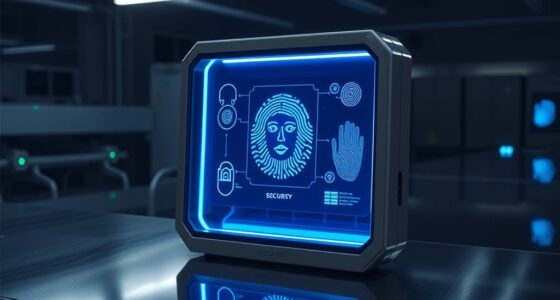The future of passwordless authentication is promising, offering enhanced security and ease of use. You’ll be able to verify your identity quickly through biometric methods like fingerprints or facial recognition, reducing reliance on traditional passwords. Token-based systems, combined with advanced AI, are creating layered security that’s difficult for cybercriminals to breach. If you keep exploring, you’ll discover how these innovations are shaping a more secure and seamless digital experience for everyone.
Key Takeaways
- Biometric authentication, such as fingerprint and facial recognition, will become the primary method for secure, passwordless access.
- Multi-factor solutions combining biometrics and token-based systems will enhance security and user convenience.
- AI and machine learning will enable real-time anomaly detection, preventing unauthorized access proactively.
- Cloud-based, seamless authentication processes will support consistent security across diverse devices and platforms.
- Advances in high-precision biometric technology, like 4K calibration, will improve accuracy and reliability of passwordless systems.

As cybersecurity threats continue to evolve, traditional password-based authentication often falls short in protecting your accounts. Hackers find new ways to crack passwords, making breaches more common and costly. That’s where the future of passwordless authentication truly shines, offering more secure and user-friendly alternatives. Biometric security is one of the most promising innovations, allowing you to verify your identity through unique physical traits like fingerprints, facial recognition, or even iris scans. Instead of remembering complex passwords or worrying about them being stolen, you simply use your body to authenticate. This method not only speeds up the login process but also markedly reduces the risk of unauthorized access, since biometric data is difficult to replicate or steal.
Biometric security enhances login speed and reduces risks by verifying your unique physical traits instead of passwords.
Alongside biometric security, token-based access is gaining traction as a reliable way to authenticate users without passwords. When you use token-based systems, you’re provided with a unique, time-sensitive token—often delivered via a mobile app, hardware token, or a secure email link—that verifies your identity. Unlike passwords, these tokens are dynamic, changing frequently, which makes them much harder for cybercriminals to intercept and misuse. Token-based access can be integrated into multi-factor authentication setups, further strengthening your security. For example, combining biometrics with a token creates a layered barrier that’s tough to breach, even if one factor is compromised.
The future of passwordless authentication is also moving toward seamless, frictionless experiences. Imagine logging into your accounts with just a quick glance or a fingerprint scan—no more fumbling with complex passwords or worrying about password reuse across sites. This not only improves security but also enhances convenience, which is fundamentally important as digital interactions become more embedded in daily life. Cloud-based authentication solutions are making this easier to implement across devices and platforms, ensuring consistent security regardless of where or how you access your accounts.
Furthermore, advances in artificial intelligence and machine learning are helping authentication systems adapt to your behaviors, making them smarter and more secure. These systems can analyze your typical login patterns, device usage, and biometric data to detect anomalies and prevent unauthorized access in real-time. As these technologies mature, you’ll likely see more personalized, secure, and passwordless experiences that are both resilient against threats and simple to use. In addition, the integration of high-accuracy 4K resolution and advanced calibration techniques can further enhance biometric identification accuracy, making authentication even more reliable. Ultimately, the shift away from traditional passwords toward biometric security and token-based access signifies a future where cybersecurity is more intuitive, resilient, and user-centric.
Frequently Asked Questions
How Will Passwordless Authentication Impact Small Businesses?
You’ll find that passwordless authentication makes your digital transformation smoother and enhances user experience. Without the hassle of remembering passwords, your customers can access your services more quickly and securely. This reduces friction and boosts satisfaction. As a small business, adopting these methods helps you stay competitive, protect data better, and streamline operations, all while offering a modern, seamless experience that keeps users engaged and coming back.
What Are the Privacy Concerns Associated With Biometric Data?
You should be aware that biometric data raises significant privacy concerns, especially regarding biometric privacy and data protection. When you use fingerprints or facial recognition, your sensitive information could be vulnerable to hacking or misuse. Without proper safeguards, your biometric data might be stored insecurely or shared without your consent, risking identity theft. Ensuring strong data protection measures and clear privacy policies is essential to keep your biometric information safe.
Can Passwordless Methods Replace All Traditional Authentication Forms?
Sure, passwordless methods might seem like the superheroes of authentication, but they can’t save the day from biometric limitations or user acceptance issues. You’ll still face challenges like false positives, device dependency, and privacy concerns. While they’re great for convenience, expecting them to replace *all* traditional forms is wishful thinking. You’ll need a mix—because no single method, including biometrics, can handle every security scenario perfectly.
How Secure Is Biometric Authentication Against Spoofing Attacks?
Biometric authentication’s security depends on addressing biometric vulnerabilities and implementing effective spoofing countermeasures. While fingerprint and facial recognition systems are advanced, they can still be tricked by sophisticated spoofing attacks. To stay secure, you should guarantee devices use liveness detection and multi-factor authentication. These measures help reduce risks, making biometric methods more reliable against spoofing, though no system is entirely immune to determined attackers.
What Are the Costs Involved in Implementing Passwordless Systems?
Implementing passwordless systems is like planting a new garden—you’ll face initial costs and effort. You need to cover implementation costs for hardware, software, and integration, plus invest in user training to facilitate smooth adoption. While upfront expenses might seem high, they often lead to long-term savings on security breaches and support. Preparing your team and infrastructure now makes the shift easier and more effective, ultimately growing a safer, more efficient system.
Conclusion
You might worry that passwordless authentication isn’t secure enough, but advancements like biometric verification and device-based tokens make it safer than traditional passwords. It’s easy to use, reduces frustration, and minimizes the risk of hacking. Embracing this future means you won’t have to remember complex passwords or worry about breaches. So, don’t hesitate—switching now can protect your digital life and simplify your online experience. The future’s passwordless, and it’s better for you.









